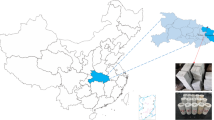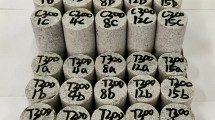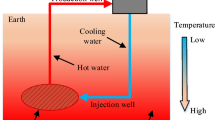Abstract
Granite at a high temperature can cause a decrease in strength and cracking when exposed to a rapid cooling shock. Therefore, the cooling shock method can be considered as a potential cracking technology to improve the energy exploitation efficiency. The thermal cracking damage of high-temperature granite after cooling shock induced by different low-temperature refrigerants were studied. Firstly, granite samples were heated to different targeted temperatures (i.e.100, 300, 500, and 700 °C). Then, all heated samples were respectively soaked in these refrigerants with different temperatures (i.e. 20, 0, − 10, − 20 and − 30 °C) or cooled in the air condition as a reference. When the cooling process ends, the effects of cooling shock on the strength characteristics and failure modes of high-temperature granites were respectively observed by acoustic wave, uniaxial compression test and the acoustic emission (AE) test. Some main conclusions are: (1) The high temperature granite p-wave velocity tends to decreases with the refrigerant temperature decreases. (2) The lower CaCl2 solution temperature is, the lower the peak strength. The specific performance is that the higher granite temperature, the more obvious the granite strength decreases after the cooling shock. (3) The curves under different temperature gradients performs from a “single/double peak” to a “multipeak” as the refrigerant temperature decreases. (4) The failure modes of granite subjected to different temperature gradients are obviously different, of which X-type shear failure is shown above 500 °C. These studies verify the strong effect of cooling shocks on high-temperature granite. Scholars can draw on the experience of cooling shock technology in the geothermal development of late-stage high-temperature rock masses.










Similar content being viewed by others
References
Abdulagatova ZZ, Kallaev SN, Omarov ZM, Bakmaev AG, Grigor’ev BA, Abdulagatov IM (2020) Temperature effect on thermal-diffusivity and heat-capacity and derived values of thermal-conductivity of reservoir rock materials. Geomech Geophys Geo-Energ Geo-Resour 6(1):8. https://doi.org/10.1007/s40948-019-00131-2
Alqatahni NB, Cha M, Yao B, Yin X, Kneafsey TJ, Wang L, Wu YS, Miskimins JL (2016) Experimental investigation of cryogenic fracturing of rock specimens under true triaxial confining stresses, Spe Europec featured at 78th Eage conference and exhibition. Soc Petrol Eng. https://doi.org/10.2118/180071-MS
Axelsson G, Thórhallsson SJGRCT (2009) Review of well stimulation operations in Iceland. Geothermal Resour Council Trans 33:795–800
Badulla I, Ranjith G, Tharaka R, Mandadige P, Dornadula C, Wanniarachchige K (2018) An influence of thermally-induced micro-cracking under cooling treatments: mechanical characteristics of australian granite. Energies. https://doi.org/10.3390/en11061338
Chaki S, Takarli M, Agbodjan WP (2008) Influence of thermal damage on physical properties of a granite rock: porosity, permeability and ultrasonic wave evolutions. Constr Build Mater 22(7):1456–1461. https://doi.org/10.1016/j.conbuildmat.2007.04.002
Chen YL, Wei ZA, Xu J, Tang XJ, Yang HW, Li SC (2011) Experimental research on the acoustic emission characteristics of rock under uniaxial compression. J China Coal Soc. https://doi.org/10.3321/j.issn:1001-1250.2008.10.007
Chen S, Yang C, Wang G (2017) Evolution of thermal damage and permeability of Beishan granite. Appl Therm Eng 110:1533–1542. https://doi.org/10.1016/j.applthermaleng.2016.09.075
Gang W, Song-Tao Z, Yu W (2015) Research on characteristics of mesostructure and acoustic emission of granite under high temperature. Rock Soil Mech 36:351–356. https://doi.org/10.16285/j.rsm.2015.S1.060
Glassley WE (2014) Geothermal energy: renewable energy and the environment. CRC Press. https://doi.org/10.1080/15567036.2015.1085286
Hartlieb P, Toifl M, Kuchar F, Meisels R, Antretter T (2016) Thermo-physical properties of selected hard rocks and their relation to microwave-assisted comminution. Miner Eng 91:34–41. https://doi.org/10.1016/j.mineng.2015.11.008
Homand-Etienne F, Houpert R (1989) Thermally induced microcracking in granites: characterization and analysis. Int J Rock Mech Min Sci Geomech Abstracts 26(2):125–134. https://doi.org/10.1016/0148-9062(89)90001-6
Huang ZW, Wen HT, Wu XG, Li GS, Yang RY, Li R, Zhang CC (2019) Experimental study on cracking of high temperature granite using liquid nitrogen. J China Univ Petrol 43(2):68–76. https://doi.org/10.3969/j.issn.1673-5005.2019.02.008
Ichiro O (1995) Temperature variation of elastic properties of α-quartz up to the α-β transition. J Phys Earth 43(2):157–169. https://doi.org/10.4294/jpe1952.43.157
Liu S, Xu JY (2015) An experimental study on the physico-mechanical properties of two post-high-temperature rocks. Eng Geol 185:63–70. https://doi.org/10.1016/j.enggeo.2014.11.013
Nasseri MHB, Schubnel A, Young RP (2007) Coupled evolutions of fracture toughness and elastic wave velocities at high crack density in thermally treated Westerly granite. Int J Rock Mech Min Sci 44(4):601–616. https://doi.org/10.1016/j.ijrmms.2006.09.008
Nasseri MHB, Schubnel A, Benson PM, Young RP (2009) Common evolution of mechanical and transport properties in thermally cracked westerly granite at elevated hydrostatic pressure. Pure Appl Geophys 166(5–7):927–948. https://doi.org/10.1007/s00024-009-0485-2
Sagar RV, Prasad BKR, Kumar SS (2012) An experimental study on cracking evolution in concrete and cement mortar by the b-value analysis of acoustic emission technique. Cem Concr Res 42(8):1094–1104. https://doi.org/10.1016/j.cemconres.2012.05.003
Shao S, Wasantha PLP, Ranjith PG, Chen BK (2014) Effect of cooling rate on the mechanical behavior of heated Strathbogie granite with different grain sizes. Int J Rock Mech Min Sci 70:381–387. https://doi.org/10.1016/j.ijrmms.2014.04.003
Shao S, Ranjith PG, Wasantha PLP, Chen BK (2015) Experimental and numerical studies on the mechanical behaviour of Australian Strathbogie granite at high temperatures: an application to geothermal energy. Geothermics 54:96–108. https://doi.org/10.1016/j.geothermics.2014.11.005
Shen YJ, Hou X, Yuan JQ, Zhao CH (2019) Experimental study on temperature change and crack expansion of high temperature granite under different cooling shock treatments. Energies. https://doi.org/10.3390/en12112097
Shen YJ, Hou X, Yuan JQ, Wang SF, Zhao CH (2020) Thermal cracking characteristics of high-temperature granite suffering from different cooling shocks. Int J Fracture. https://doi.org/10.1007/s10704-020-00470-2
Singh HK (2020) Geothermal energy potential of Indian oilfields. Geomech Geophys Geo-energ Geo-resour 6:19. https://doi.org/10.1007/s40948-020-00148-y
Siratovich PA, Sass I, Homuth S, Bjornsson A (2011) Thermal stimulation of geothermal reservoirs and laboratory investigation of thermally-induced fractures. Trans-Geotherm Resour Council 35(10):1529–1535. https://doi.org/10.2307/1908233
Siratovich PA, Villeneuve MC, Cole JW, Kennedy BM, Bégué F (2015) Saturated heating and quenching of three crustal rocks and implications for thermal stimulation of permeability in geothermal reservoirs. Int J Rock Mech Min Sci 80:265–280. https://doi.org/10.1016/j.ijrmms.2015.09.023
Somerton WH, Boozer GD (2010) A method of measuring thermal diffusivities of rocks at elevated temperatures. AIChE J 7(1):87–90. https://doi.org/10.1002/aic.690070121
Sun Q, Zhang Z, Xue L, Zhu S (2013) Physico-mechanical properties variation of rock with phase transformation under high temperature. Chin J Rock Mech Eng 32(5):935–942
Sun Q, Zhang W, Xue L, Zhang Z, Su T (2015) Thermal damage pattern and thresholds of granite. Environ Earth Sci 74(3):2341–2349. https://doi.org/10.1007/s12665-015-4234-9
Sun H, Sun Q, Deng W, Zhang W, Lü (2017) Temperature effect on microstructure and P-wave propagation in Linyi sandstone. Appl Therm Eng 115:913–922. https://doi.org/10.1016/j.applthermaleng.2017.01.026
Thierry R, Haore SG, Darot M (2006) The effect of heating on the microstructural evolution of La Peyratte granite deduced from acoustic velocity measurements. Earth Planet Sci Lett 243(3–4):692–700. https://doi.org/10.1016/j.epsl.2006.01.038
Venturini Autieri MR, Dulieu-Barton JM (2006) Initial Studies for AE Characterisation of Damage in Composite Materials. Adv Mater Res 13–14:273–280. https://doi.org/10.4028/www.scientific.net/AMR.13-14.273
Wang HL, Song YP (2007) Ultrasonic pulses behavior in various-size concrete specimens under compression. J Dalian Univ Technol 47(1):90–94. https://doi.org/10.1016/S1872-2067(07)60006-0
Xin Y, Zhuang L, Sun ZX (2020) Numerical investigation on the effects of the fracture network pattern on the heat extraction capacity for dual horizontal wells in enhanced geothermal systems. Geomech Geophys Geo-energ Geo-resour 6:32. https://doi.org/10.1007/s40948-020-00151-3
Yang SQ, Jing HW, Huang YH, Ranjith PG, Jiao YY (2014) Fracture mechanical behavior of red sandstone containing a single fissure and two parallel fissures after exposure to different high temperature treatments. J Struct Geol 69(dec.pt.a):245–264. https://doi.org/10.1016/j.jsg.2014.10.014
Yang SQ, Ranjith PG, Jing HW, Tian WL, Ju Y (2017) An experimental investigation on thermal damage and failure mechanical behavior of granite after exposure to different high temperature treatments. Geothermics 65(jan):180–197. https://doi.org/10.1016/j.geothermics.2016.09.008
Yu K et al (2020) Near-room-temperature thermoelectric materials and their application prospects in geothermal power generation. Geomech Geophys Geo-energ Geo-resour 6(1):1–25. https://doi.org/10.1007/s40948-019-00134-z
Zhang YL, Zhao GF (2020) A global review of deep geothermal energy exploration: from a view of rock mechanics and engineering. Geomech Geophys Geo-energ Geo-resour 6(1):763–777. https://doi.org/10.1007/s40948-019-00126-z
Zhang F, Zhao J, Hu D, Skoczylas F, Shao J (2017) Laboratory investigation on physical and mechanical properties of granite after heating and water-cooling treatment. Rock Mech Rock Eng 51(3):677–694. https://doi.org/10.1007/s00603-017-1350-8
Zhao J, Tang CA, Wang SJ (2020) Excavation based enhanced geothermal system (EGS-E): introduction to a new concept. Geomech Geophys Geo-energ Geo-resour. https://doi.org/10.1007/s40948-019-00127-y
Zuo JP, Wang JT, Sun YJ, Chen Y, Jiang GH, Li YH (2017) Effects of thermal treatment on fracture characteristics of granite from Beishan, a possible high-level radioactive waste disposal site in China. Eng Fract Mech 182:425–437. https://doi.org/10.1016/j.engfracmech.2017.04.043
Acknowledgments
We thank for the supports from the Natural Science Foundation of Shaanxi Province, China (Grant No.2018JQ5124), Shaanxi Province New-Star Talents Promotion Project of Science and Technology (Grant No.2019KJXX-049), the Foundation from State Key Laboratory for Geo-Mechanics and Deep Underground Engineering, China University of Mining & Technology (Grant No. SKLGDUEK1813) and the National Natural Science Foundation of China (Grant No. 41772333).
Funding
This research was funded by Shaanxi Province New-Star Talents Promotion Project of Science and Technology (Grant No.2019KJXX-049), the National Natural Science Foundation of China (Grant No. 41772333), the Natural Science Foundation of Shaanxi Province, China (Grant No.2018JQ5124), and the Foundation from State Key Laboratory for Geo-Mechanics and Deep Underground Engineering, China University of Mining & Technology (Grant No. SKLGDUEK1813).
Author information
Authors and Affiliations
Contributions
Y.-j.S. and X.H. conceived and designed the experiments; J.-q.Y., and X.H performed the experiments, J.-q.Y., X.H, J-s H and Z-p B analyzed the data; Y.-j.S. and T.L. contributed funding supports; J.-q.Y. wrote the paper. Y.-j.S. revised the English of this paper.
Corresponding author
Ethics declarations
Conflict of interest
On behalf of all authors, the corresponding author states that there is no conflict of interest.
Additional information
Publisher's Note
Springer Nature remains neutral with regard to jurisdictional claims in published maps and institutional affiliations.
Rights and permissions
About this article
Cite this article
Shen, Y., Yuan, J., Hou, X. et al. The strength changes and failure modes of high-temperature granite subjected to cooling shocks. Geomech. Geophys. Geo-energ. Geo-resour. 7, 23 (2021). https://doi.org/10.1007/s40948-020-00214-5
Received:
Accepted:
Published:
DOI: https://doi.org/10.1007/s40948-020-00214-5




